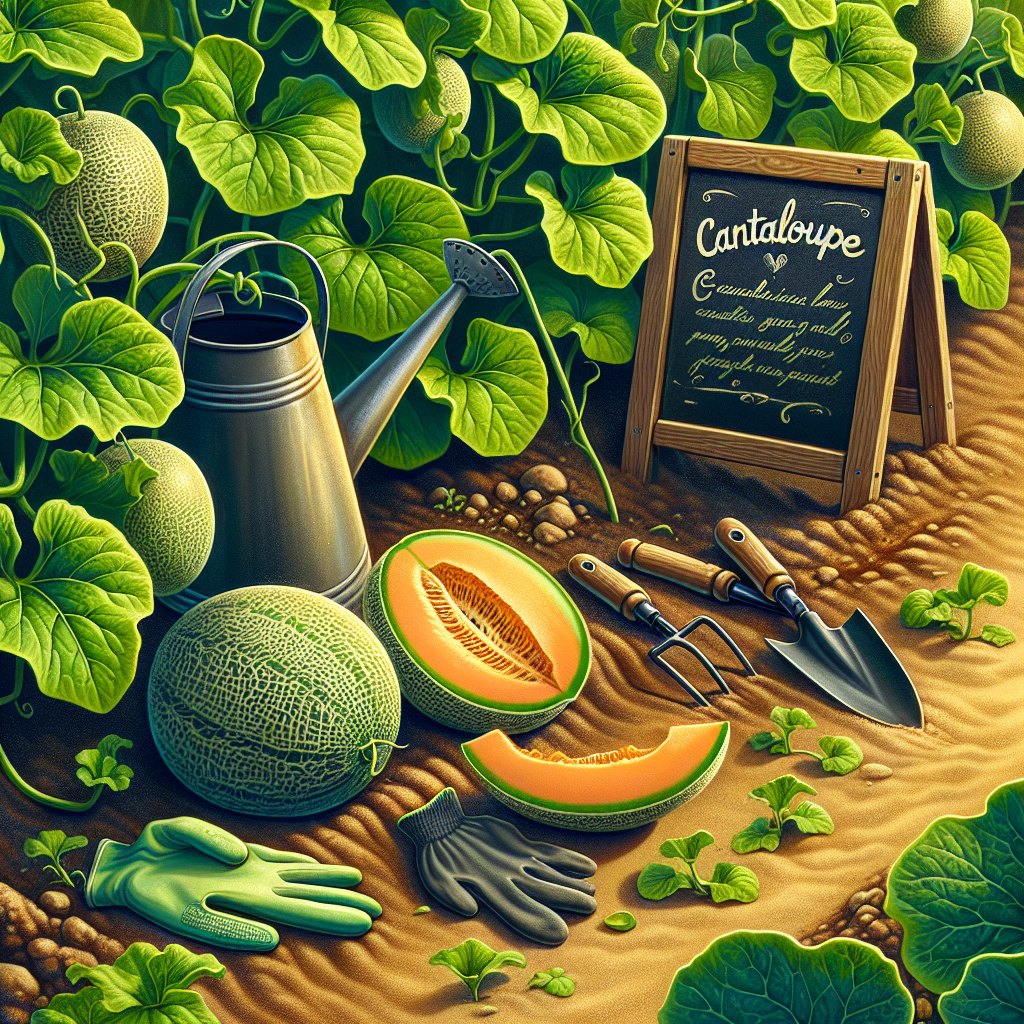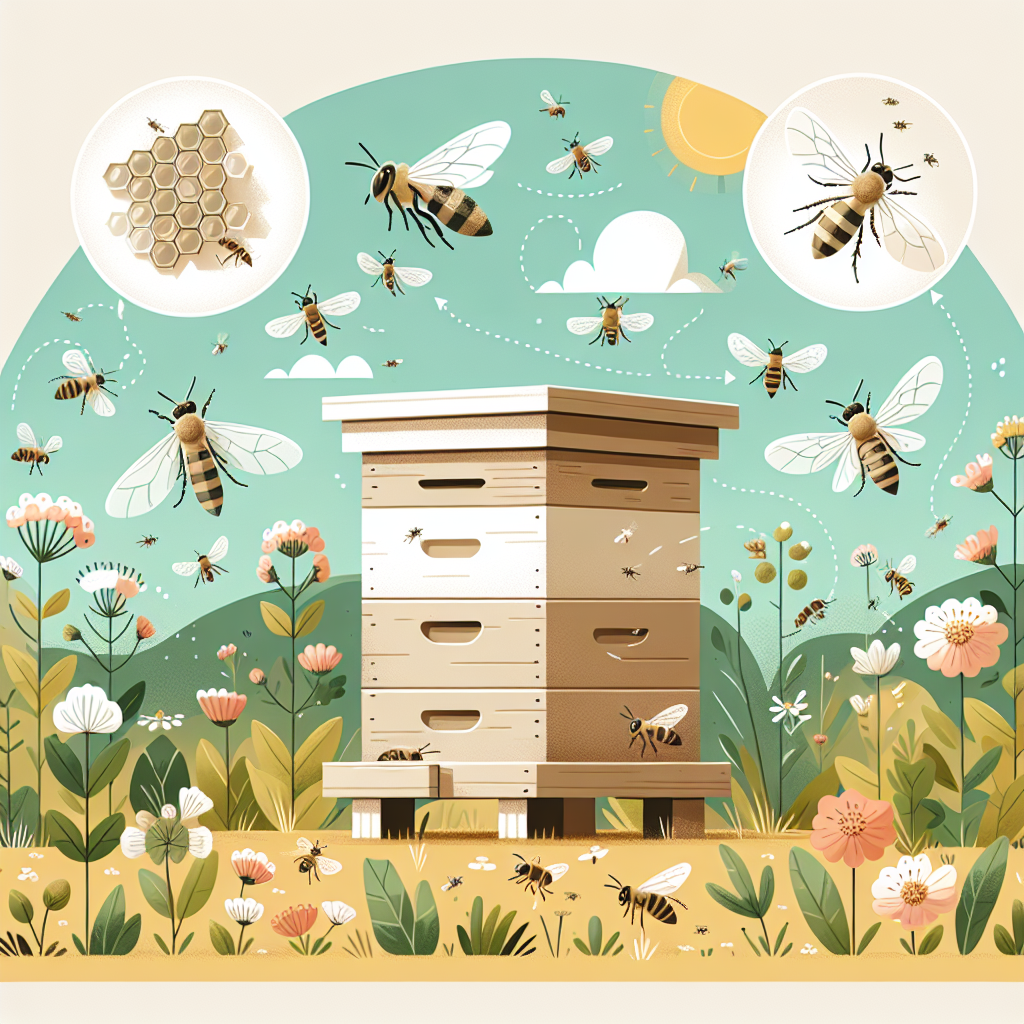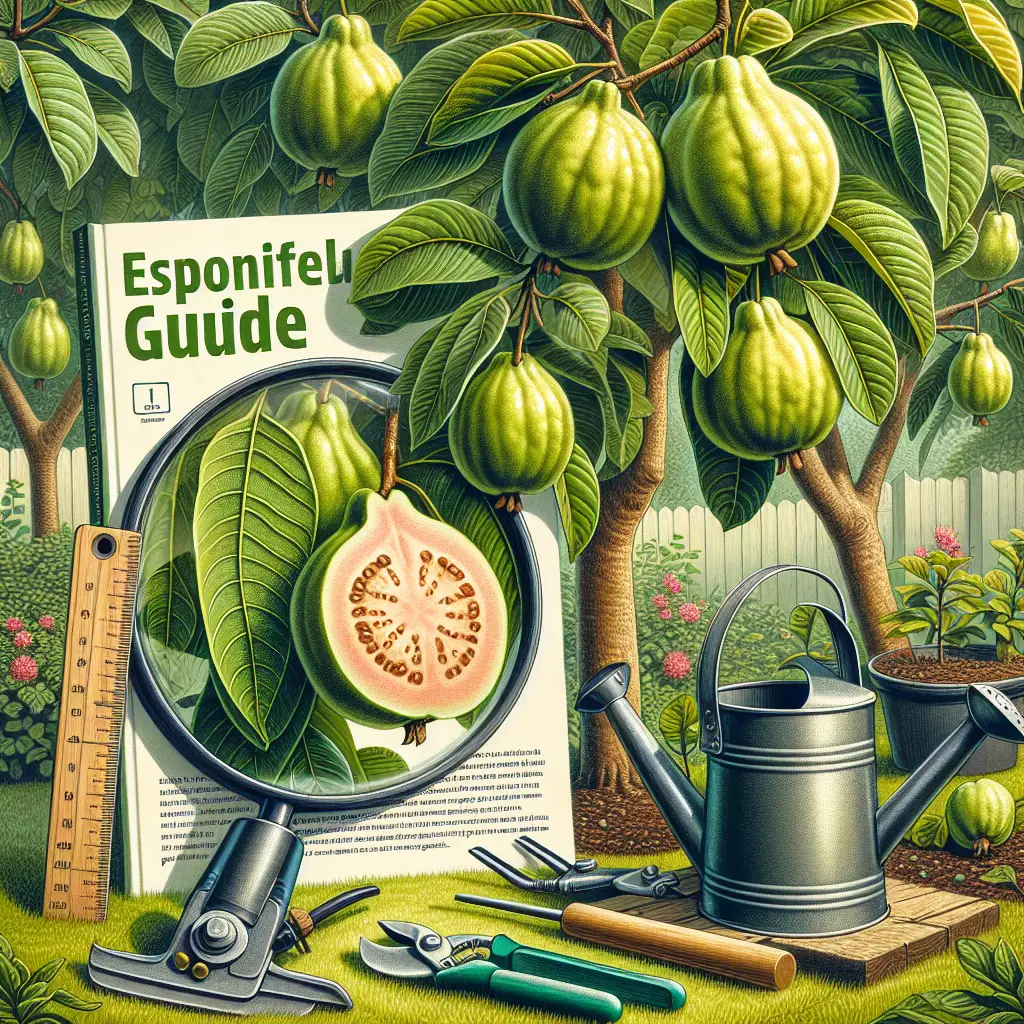Cultivating Cantaloupe Melons for Sweetness
Updated May 30, 2024 at 3:59 pm

Getting Started with Cantaloupe Melons
- Pet Friendly: Generally safe for pets, but keep an eye on them to avoid any choking hazard from eating the rinds or seeds.
- Light Requirements: Full sun is ideal for sweet and juicy maturity.
- Watering: Consistent watering is key, but overwatering can lead to less sweet melons.
- Humidity: Tolerates most humidity levels but thrives in moderate to high humidity.
- Temperature: Prefers warm conditions, ideally between 70 to 85 degrees Fahrenheit.
- Difficulty: Moderate. Requires attentive care, particularly in water management and pest control.
Choosing the Right Variety for Maximum Sweetness
When cultivating cantaloupe melons, starting with the right variety is crucial. There are many types of cantaloupes, each with its own sweetness and flavor profile.
For example, ‘Hale’s Best Jumbo’ is a popular choice known for its incredibly sweet taste and large fruit size. This variety has rugged skin that protects it from pests and diseases.
Find This and More on Amazon
Planting at the Perfect Time
Timing is paramount when planting cantaloupes. In most regions, the best time to plant is after the last frost when the soil is warm, ensuring a better chance for the seeds to germinate and grow.
Ideal plant timing can vary depending on your climate zone, but generally, it’s recommended to plant in late spring to early summer.
Soil Preparation for Cantaloupe Sweetness
Soil quality can make or break your cantaloupe crop. Cantaloupes thrive in well-drained, loamy soil with plenty of organic matter.
Before planting, it’s a good idea to test your soil and amend it with compost to improve its structure and fertility. This will encourage healthy growth and superior fruit sweetness.
Irrigation Techniques for Juicy Melons
Water management is critical in cultivating cantaloupes. Inconsistent watering can lead to split melons, while overwatering can dilute the sugar content, resulting in less sweet fruit.
A drip irrigation system can help provide consistent moisture directly to the roots without over-saturating the soil. It said that people say this method also conserves water and reduces weed growth.
Mastering Nutrients for Optimal Growth
Cantaloupes are heavy feeders, requiring well-balanced nutrients to grow to their full potential.
Applying a balanced fertilizer early in the growth stage and then switching to a phosphorus and potassium-rich formula can encourage fruit development and sweetness. The Miracle-Gro Shake ‘N Feed Tomato, Fruit & Vegetable Plant Food, for instance, is often praised for being a reliable choice.
Find This and More on Amazon
Pest and Disease Management
Pests and diseases can destroy your cantaloupe crop, making prevention and early treatment essential.
Using floating row covers can protect your plants from insects, and removing any infected plants will help prevent the spread of diseases. Organic insecticides or neem oil treatments can also be effective.
Understanding the Growth Stages
Cantaloupes go through several growth stages, from seed germination to fruiting. Monitoring these stages is important to provide the right care at the right time.
For instance, during the vegetative growth stage, cantaloupes need ample nitrogen for healthy vines, while during fruiting, reducing nitrogen can enhance sweetness.
Harvesting at Peak Ripeness
Picking cantaloupes at the right time is critical for flavor. When the melon detaches easily from the vine with a gentle tug, it indicates peak ripeness and optimal sweetness.
Additionally, the fruit should have a sweet fragrant aroma at the blossom end and the netting on the rind should be pronounced.
Post-Harvest Handling and Storage
After harvesting, proper handling is important to maintain the sweetness of your cantaloupes. They should be kept at a cool temperature to slow down the ripening process and preserve their flavor.
However, cantaloupes should not be refrigerated until they are cut open, as this can deter taste and texture.
The Aroma of a Ripe Cantaloupe
One of the defining features of a perfectly ripe cantaloupe is its aroma. A fragrant, musky smell near the stem end indicates that the cantaloupe is at its peak sweetness and ready to enjoy.
Feel free to give it a sniff at the grocery store or in your garden, this simple check can be a surprisingly reliable indicator of ripeness.
Pruning for Bigger, Sweeter Fruit
To encourage larger and sweeter cantaloupes, pruning is essential. Reducing the number of fruits per plant allows the plant to direct more energy into producing fewer fruits of higher quality.
It’s a technique that might require a bit of courage — to cut away potential fruit — but the reward of sweeter, bigger melons is often worth it.
Encouraging Pollination
Pollination is vital for fruit production. If you have limited bee activity in your area, you might need to hand-pollinate flowers to ensure fruit set.
This can be done by transferring pollen from the male flowers to the female flowers using a small paintbrush or even your fingertip.
Benefits of Mulching
Mulching around cantaloupe plants can help maintain moisture, regulate soil temperature, and prevent weeds.
Organic mulches such as straw or wood chips are popular choices. They not only serve their purpose during the growing season but also enrich the soil as they decompose.
Frequent Questions on Cultivating Cantaloupes
Here, we address some common questions you might have about growing cantaloupes, from the ideal soil pH to dealing with common pests and diseases.
You’ll learn how to ensure your plants get the best possible start and how to treat problems should they arise.
The Visual Appeal of Cantaloupe Vines
Beyond their delicious fruit, cantaloupe vines have a charming aesthetic with their sprawling growth and attractive foliage.
Healthy vines are key to a successful harvest, and they can also add a lush, green look to your garden space.
The Delight of Home-grown Cantaloupes
There’s a certain pride that comes with growing your own cantaloupes. The freshness of a home-grown crop can’t be matched by store-bought alternatives, and the sweetness is often much more pronounced.
When you slice open a cantaloupe you have nurtured from seed to fruit, the flavor and aroma are especially rewarding.
Conclusion
In summary, cultivating cantaloupes for sweetness involves selecting the right variety, optimal planting timing, careful soil and water management, understanding the importance of nutrients, pest and disease control, pruning for fruit size, and knowing when to harvest for peak flavor.
With patience and commitment, your home garden can produce cantaloupes that are not only sweet and juicy but also a source of pride and enjoyment.
Picking the Perfect Location for Your Cantaloupe Garden
Location plays a significant role in the overall health and sweetness of your cantaloupes. Choose a spot in your garden that receives full sun for the majority of the day, as cantaloupes are sun-loving fruits.
Also, ensure the chosen location has good air circulation to prevent diseases and that the soil is well-draining to avoid waterlogged roots, which can negatively affect fruit quality.
Companion Planting with Cantaloupes
Implementing companion planting can greatly improve your cantaloupe garden’s success. Certain plants can deter pests naturally and promote strong growth in your cantaloupes.
For instance, planting marigolds nearby can repel harmful nematodes, while radishes can serve as a trap crop for flea beetles which might otherwise target young cantaloupe plants.
Training Vines on Trellises
Another technique for potentially sweeter cantaloupes is training the vines to grow on trellises. This method improves air circulation, which reduces the risk of fungal diseases, and ensures the fruits are not sitting on moist soil where they can rot.
When installing a trellis, make sure it’s sturdy enough to support the weight of the fruit as it grows. Using slings made from old t-shirts or pantyhose can help support the weight of the developing melons on the trellis.
Optimizing Flowering for Fruit Set
Flowering is a critical stage for fruit development in cantaloupes. It’s key to ensure that there are enough pollinators in your garden to visit the blooms. Consider planting flowers that attract bees to increase pollination rates.
If pollinator activity is low, as mentioned previously, hand-pollination may be necessary—just gently touch the insides of the male flower with your paintbrush or finger, then transfer the pollen to the female flowers.
Organic Approaches to Cantaloupe Growing
For those of you interested in organic horticulture, there are several natural methods to enhance the sweetness and quality of your cantaloupe melons.
Using organic fertilizers such as fish emulsion or seaweed extract can provide plants with essential nutrients without the use of chemicals. This not only supports sustainable gardening practices but also helps in producing fruits with robust, natural flavors.
At-Home Cantaloupe Taste Test
A fun activity once your cantaloupes are harvested is to have a taste test. Compare the flavors of the cantaloupes grown in your garden to those bought in the store. You’ll likely notice that your home-grown cantaloupes are much sweeter and have a fresher taste.
This can also be a learning experience to adjust your growing techniques for the next season to enhance flavor and sweetness even further.
Creating Microclimates for Cantaloupes
A microclimate refers to a small area within your garden where the environmental conditions differ from the surrounding space. You can create microclimates to suit the needs of your cantaloupes for optimal growth.
Use elements like rocks or water containers to store heat during the day and release it at night, helping to keep the cantaloupe plants warm. Similarly, windbreaks can protect sensitive plants from strong winds that may cause physical damage to the vines or fruits.
Mitigating Weather Extremes for Cantaloupe Care
Weather can be unpredictable, and swings in temperature or sudden storms can affect cantaloupe sweetness. Be ready to protect your plants with row covers if a late frost threatens or provide shade cloth during particularly intense heatwaves.
Always keep an eye on the weather forecast and be prepared to act quickly to mitigate any weather extremes that could compromise your cantaloupe crop.
Understanding Cantaloupe Biology for Better Growth
It’s helpful to have a basic understanding of cantaloupe biology, such as knowing the difference between male and female flowers or recognizing signs of nutrient deficiencies in leaves. A savvy grower is an informed grower.
Familiarizing yourself with plant health and the lifecycle of cantaloupes will enable you to make informed, timely decisions throughout the growing process, leading to sweeter and healthier melons.
Regular Monitoring and Adjustment
Consistent monitoring of your cantaloupe plants allows for quick detection and action against potential issues. Checking your plants regularly for signs of pests or diseases and adjusting your care routine accordingly can make a huge difference in the quality and sweetness of your cantaloupes.
Maintaining a garden journal with detailed notes on what you’ve observed, alongside corresponding action taken, can be an invaluable tool for honing your melon cultivation skills year after year.
Community Gardening and Cantaloupes
Participating in community gardening can be both socially enriching and beneficial for your cantaloupe growing knowledge. Sharing experiences with fellow gardeners can lead to new insights on how to improve sweetness and yield in your cantaloupe patch.
Community gardens often provide a diverse environment that supports a variety of pollinators, which is beneficial for your cantaloupes’ pollination success.
The Importance of Patience and Observation
Cultivating cantaloupe melons requires patience as well as close observation. As you witness your plants’ progress from sprouting seeds to bearing luscious fruit, take pleasure in the journey as much as the end result.
Your careful attention and the time invested in understanding the unique needs of your cantaloupe plants will undoubtedly be reflected in the delightful sweetness of the final harvest.
Sharing Your Cantaloupe Bounty
One of the joys of growing your own cantaloupes is the ability to share the fruits of your labor with friends and family. Often, home-grown produce is appreciated for its superior flavor and freshness compared to store-bought options.
Gifting a well-ripened, sweet cantaloupe can be a meaningful gesture that shares not just the fruit, but also the care and effort that went into growing it. Plus, it’s a great way to encourage others to try their hand at gardening!
Making Use of Surplus Cantaloupes
If you find yourself with more cantaloupes than you can eat, there are a variety of ways to utilize the surplus. From freezing for smoothies to creating melon-based salsas or even pickling the rinds, the options are plentiful.
Don’t let extra cantaloupes go to waste; they can be transformed into delicious dishes or stored for later use, effectively prolong their enjoyment far beyond the harvest season.
Connecting with Nature Through Cantaloupe Cultivation
Growing cantaloupe melons connects you with the rhythm of nature and the cycles of growth and harvest. There’s a natural satisfaction in working with the earth to produce food, and cantaloupes are a particularly rewarding choice given their delightful sweetness when home-grown.
By cultivating cantaloupes, you become more attuned to the subtle changes in the environment and the impact they have on plant growth, deepening your appreciation for both the process and the product.
Embracing Sustainability in Your Cantaloupe Garden
Adopting sustainable practices in your cantaloupe garden is not just great for the environment—it can also lead to healthier, sweeter fruit. Practices like composting, collecting rainwater for irrigation, and using natural pest control methods all contribute to a more sustainable approach to gardening.
By embracing these practices, you further enhance the natural growth conditions for your cantaloupes, resulting in a high-quality, sweet harvest that’s also eco-friendly.
The Health Benefits of Cantaloupes
Besides their sweetness, cantaloupes are packed with health benefits. They’re a great source of vitamins A and C, potassium, and fiber. Regularly including cantaloupe in your diet can contribute to better hydration, improved vision, and even a stronger immune system.
Not only are you nurturing sweet melons in your garden, but you’re also cultivating good health for yourself and your loved ones with every scrumptious bite.
The Pride of a Successful Cantaloupe Harvest
As your gardening season concludes with a bountiful cantaloupe harvest, take a moment to reflect on the process and appreciate the hard work that led to this point. There’s immense pride to be found in growing your own food, especially when the results are as delicious and sweet as home-grown cantaloupes.
Your efforts have not only yielded tasty fruits but have also contributed to a cycle of sustainable living and personal fulfillment. Enjoy the fruits of your labor, and remember that each gardening season is a new opportunity to learn, grow, and improve.
Nurturing Your Gardening Passion Through Cantaloupe Cultivation
Whether you’re a novice gardener or an experienced green thumb, the process of cultivating cantaloupe melons can deepen your passion for gardening. The challenges and triumphs that come with growing cantaloupes can be incredibly rewarding.
Every season offers a chance to refine your techniques, learn from your environment, and perhaps most importantly, cultivate a deliciously sweet slice of nature’s bounty right in your backyard.
Celebrating Cantaloupe Diversity
There’s a world of cantaloupe varieties out there, each with its own unique characteristics and flavors. Beyond ‘Hale’s Best Jumbo’, there are varieties like ‘Athena’, which is praised for its disease resistance and exceptional shelf life, and ‘Ambrosia’, known for its sweet and aromatic flesh.
Diversifying your crop with different types can enrich your garden’s ecosystem, extend your harvest period, and provide a range of flavors that cater to any palate.
The Critical Role of Bees in Cantaloupe Cultivation
Pollination by bees is critical for cantaloupe production. Without these essential pollinators, the majority of your flowers might never turn into fruit. If you’re growing cantaloupes, consider planting bee-friendly flowers nearby to ensure these helpful insects are frequent visitors to your garden.
Lavender and salvia are not only attractive to bees but also add beauty and fragrance to your garden space, making it a more inviting and functional area.
Understanding Cantaloupe Nutrient Requirements
Cantaloupes require different nutrients at different stages of their growth. Initially, nitrogen is important for robust vine growth. However, as the plant starts to flower and fruit, phosphorus and potassium become more critical for fruit development. Products like Dr. Earth Organic 5 Tomato, Vegetable & Herb Fertilizer are designed to meet these changing needs seamlessly.
This product boasts a blend that is ideally suited for developing the sweetness in fruits and vegetables. It’s said that gardeners have found great success in producing flavorful cantaloupes by incorporating this into their feeding regimen.
Find This and More on Amazon
Cutting Back on Water Before Harvest
Another tip for enhancing sweetness is to cut back on watering as the cantaloupes come close to harvest time. Reducing the water supply slightly forces the plants to concentrate their sugars in the fruit. However, make sure not to stress the plants too much, as this could backfire and harm the melons.
Monitoring soil moisture levels closely during this period is crucial, and tools like a soil moisture meter can be extremely helpful in getting this balance just right.
Garden Tools for Effective Cantaloupe Cultivation
Effective cantaloupe cultivation requires the right tools. A high-quality garden hoe can be beneficial for weed control and aeration, while long-handled shears are perfect for pruning. The Wilcox All Pro Stainless Steel Garden Trowel, for example, is highly durable and excellent for transplanting seedlings and detail work around your cantaloupe plants.
Gardeners often rave about how the Wilcox trowel feels like an extension of their hand, making their work in the garden both more efficient and enjoyable.
Find This and More on Amazon
Seasonal Cantaloupe Recipes to Enjoy
Your homegrown cantaloupes can be the star of many recipes. Imagine a refreshing cantaloupe salad on a hot summer day, or a soothing melon soup that’s both savory and sweet. Try blending cantaloupe into smoothies or cocktails for a unique twist. The possibilities are vast and mouthwatering!
For those with a surplus of cantaloupes, consider sharing recipes along with the fruits to inspire others and spread the joy of fresh, home-grown produce.
Conclusion and Final Thoughts on Growing Cantaloupes
To conclude, growing cantaloupes for sweetness isn’t just about a single factor, but rather a combination of various practices from selection of the right variety, to proper soil preparation, strategic watering, and careful observation. By understanding and optimizing these factors, you can increase the likelihood of a sweet and successful cantaloupe harvest.
Remember, the rewards of growing cantaloupes extend beyond the harvest itself. The process engages you with nature, provides valuable learning experiences, and ultimately, brings you the pure joy of tasting fruit that you’ve nurtured to perfection. Happy melon growing!
Shop more on Amazon

